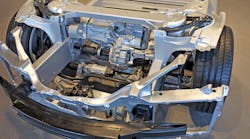One of the most rewarding aspects of working in the foundry industry is the rapid pace of change and the introduction of new ideas and technology. It may not appear this way as we observe “metalcasting” from a higher level, but as we study the design and innovation laboratories at the many companies that comprise this sector, we can see how the incentive to develop new and better ideas is always present. Most of these ideas take a considerable amount of time and resources to develop, and so often “new” ideas have been a long time in the making. Some of the exciting new trends in automotive casting are evidence of this process and will lead to significant changes in the coming years.
Larger, multi-functional cast parts. Concerning automobile manufacturing, in recent years we have seen fairly significant developments in metal processing and the overall assembly process. Examples are the rapid shift from steel to aluminum body panels, and the creation of closed-loop systems in which alloys can be recycled and repurposed for a consistent application, almost infinitely. The drivers here are not new: weight savings result in higher fuel efficiency, cost effective alloys can lower cost and recyclable materials can reduce carbon footprint.
Likewise, automotive designers’ shift toward larger structural cast parts is not prompted by new change drivers but is resulting in benefits to new vehicles. One primary driver is the determination to reduce the total number of parts needed for vehicle assembly and the simplification and cost reduction this can generate. In the case described here, over 70 parts were eliminated from the overall assembly.
Another driver is the ability to combine a vehicle’s structural requirements with its power plant so that the battery adds structural rigidity to the frame, improving overall safety and ride characteristics and lowering the center of mass. Advances like these require the entire supply chain to reimagine the way cars are made and to develop new products and processes that enable these benefits to be achieved.
Molten metal delivery evolves. Molten Metal Equipment Innovations has been evolving with this trend to meet the new requirements. We have been involved with an exciting new project at a large, California-based OEM of electric vehicles. The sizes of the castings they now need to produce has required a new paradigm in which to address the new requirements.
The size of the dose is the first new reality, requiring that 105 kgs of molten aluminum be delivered in each shot. This is more than a robotic dipper or pressure pour technology can deliver and instead the solution requires a pump that can deliver this amount of metal to the diecasting machine.
The availability of metal is crucial too, and so the technology must include a continuous information loop to ensure that the metal level remains constant. A second MMEI pump equipped with our SMART technology is used to measure the biscuit after each dose so that the precise amount of metal is available to the machine to ensure that each dose is consistent with what is needed.
The speed of the machine cycle is another new process requirement in that these large, accurate doses must be delivered in less than 9 seconds, requiring rapid metal movement without creating turbulence and other porosity creating opportunities. In testing we were able to get down to 4 seconds delivery time, and now in production 7-8 seconds is the rate.
Metal temperature also is a critical requirement in the system. MMEI, working with our partner Advanced Systems & Integration, uses proprietary heated-launder piping that maintains constant metal temperature throughout the process. We also incorporated a rotary degasser into the system to ensure the highest degree of metal quality and to prevent any porosity from getting into the part.
It’s always exciting to observe new trends as they respond to market forces and shape the future of our industry. They keep us all on our toes, and lead to some long days and late nights. This is healthy and supports new investment in the development of new materials, processes, and ultimately in new products. In our case, it has been exhilarating to work on a challenge that caused us to leave our comfort zone and branch out into some new areas. Even more, it is exciting to think about where this will take the industry and how these new trends are the collective output of all of us coming together to support new ideas.
Jeff Keller is the CEO of Molten Metal Equipment Innovations. Contact him at [email protected]









